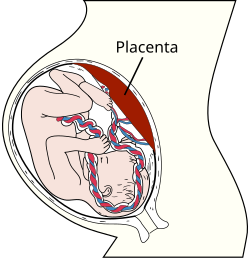Placental barrier
| placenta | |
|---|---|

Placenta
|
|

Human placenta from just after birth with the umbilical cord in place
|
|
| Details | |
| Precursor | decidua basalis, chorion frondosum |
| Identifiers | |
| Latin | Placento |
| Code | TE E5.11.3.1.1.0.5 |
|
Anatomical terminology
[]
|
|
The placenta (also known as afterbirth) is an organ that connects the developing fetus to the uterine wall to allow nutrient uptake, thermo-regulation, waste elimination, and gas exchange via the mother's blood supply; fight against internal infection; and produce hormones to support pregnancy. The placenta provides oxygen and nutrients to growing fetuses and removes waste products from the fetus's blood. The placenta attaches to the wall of the uterus, and the fetus's umbilical cord develops from the placenta. These organs connect the mother and the fetus. Placentas are a defining characteristic of placental mammals, but are also found in some non-mammals with varying levels of development. The homology of such structures in various viviparous organisms is debatable, and in invertebrates such as Arthropoda, is analogous at best.
The word placenta comes from the Latin word for cake, from Greek πλακόεντα/πλακοῦντα plakóenta/plakoúnta, accusative of πλακόεις/πλακούς plakóeis/plakoús, "flat, slab-like", in reference to its round, flat appearance in humans. The classical plural is placentae, but the form placentas is common in modern English and probably has the wider currency at present.
Prototherial (egg-laying) and metatherial (marsupial) mammals produce a choriovitelline placenta that, while connected to the uterine wall, provides nutrients mainly derived from the egg sac.
The placenta functions as a fetomaternal organ with two components: the fetal placenta (Chorion frondosum), which develops from the same that forms the fetus, and the maternal placenta (Decidua basalis), which develops from the maternal uterine tissue. It metabolises a number of substances and can release metabolic products into maternal and/or fetal circulations.
...
Wikipedia
